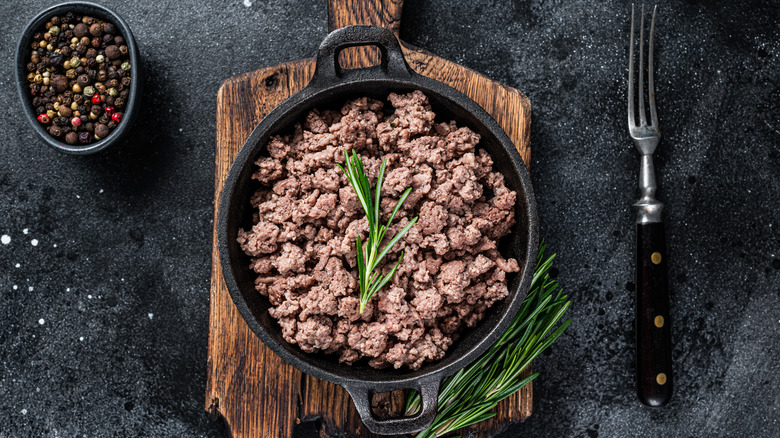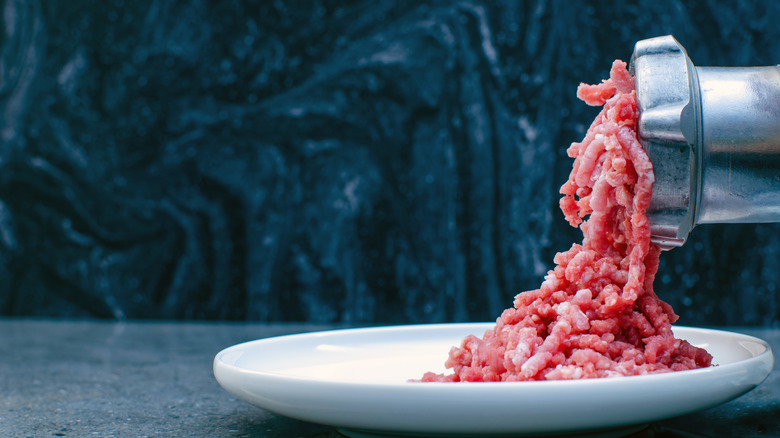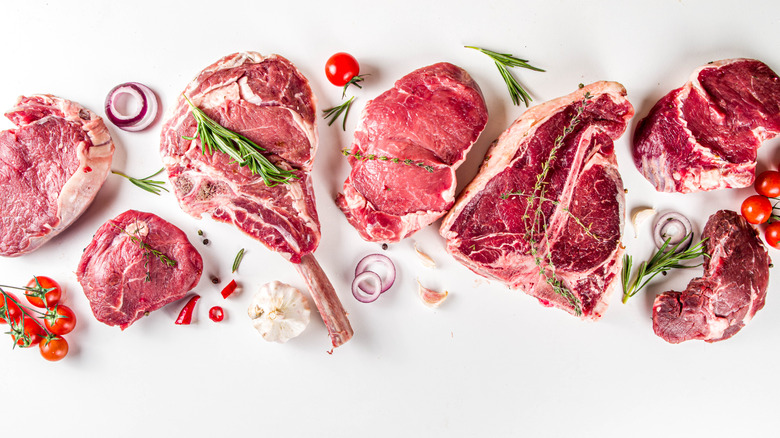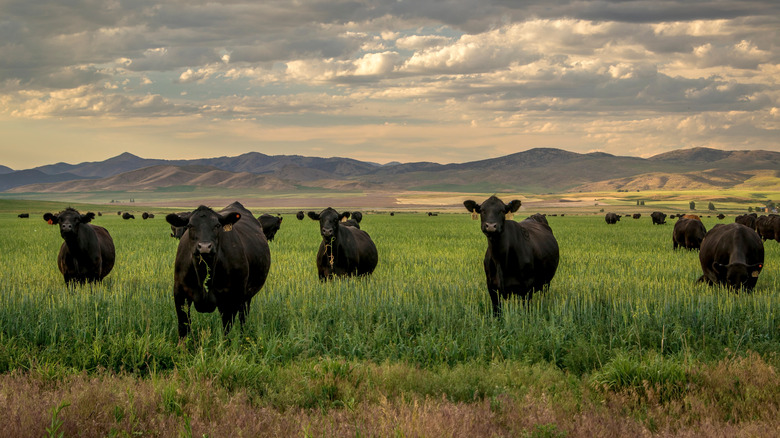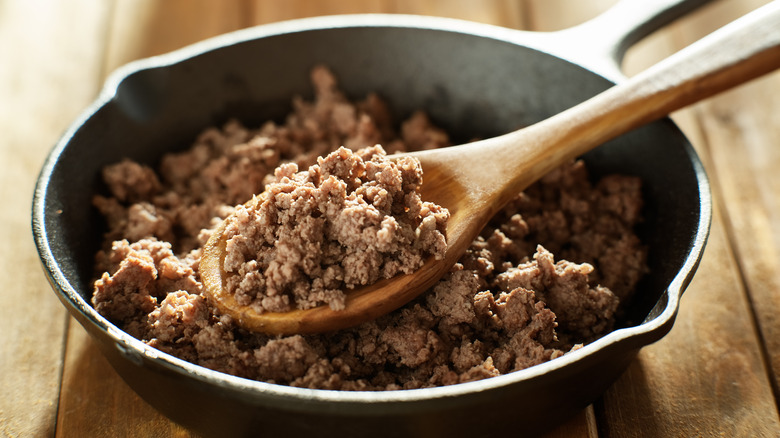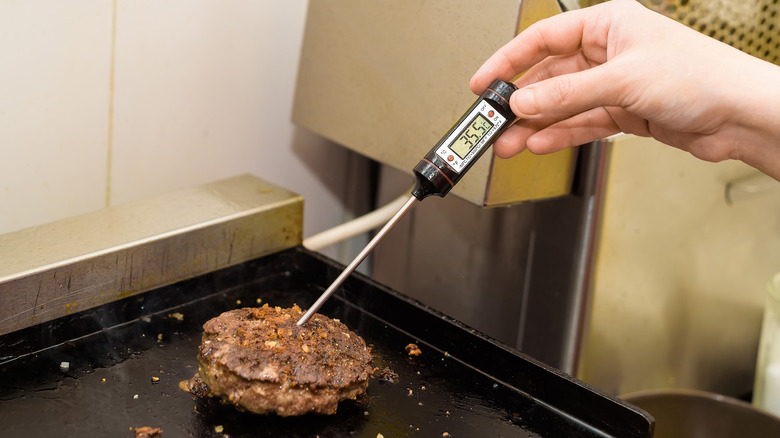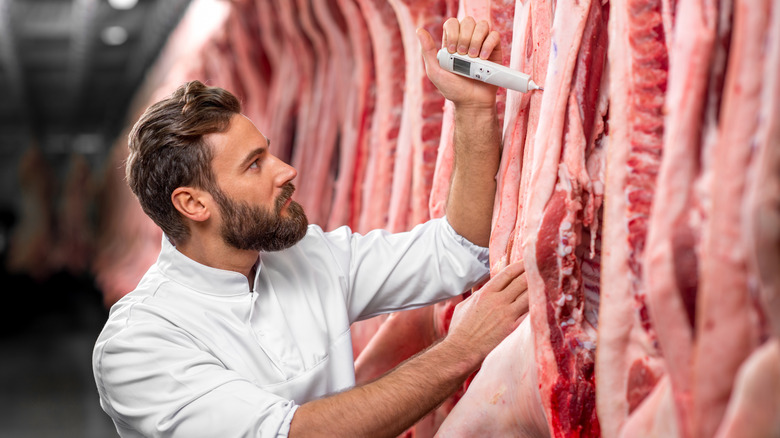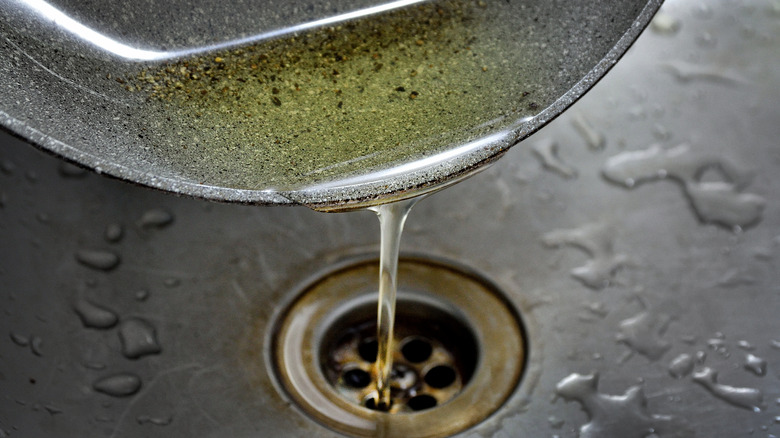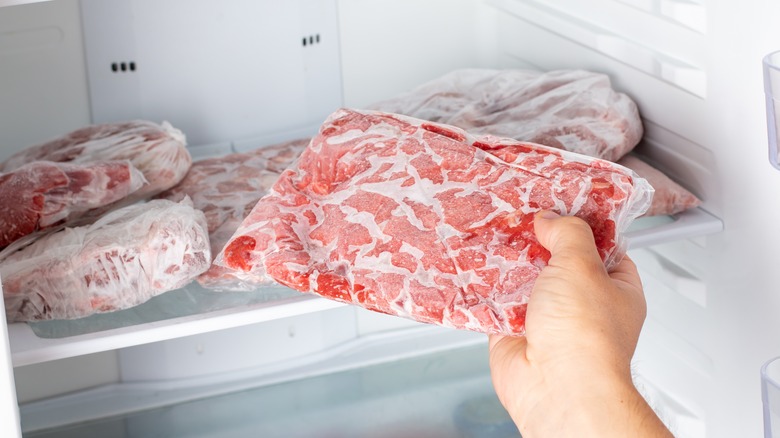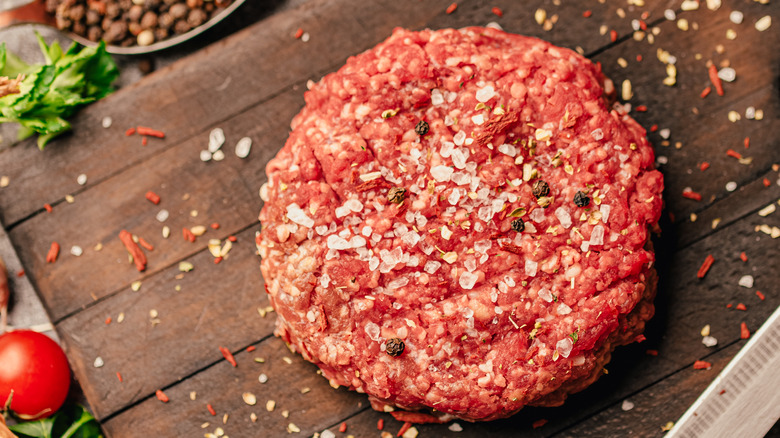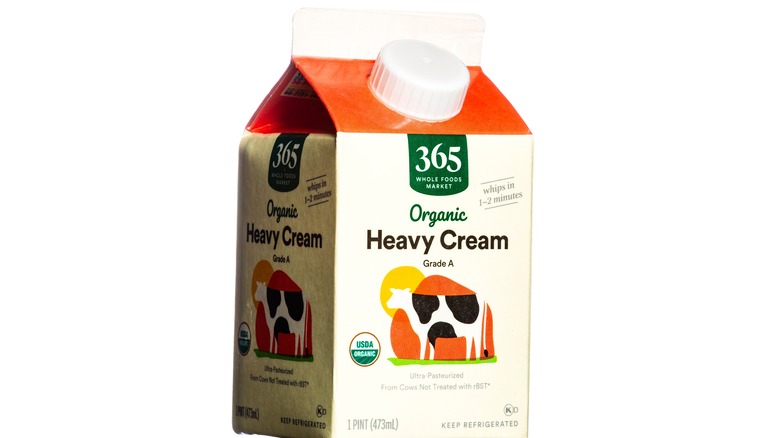Tips You Need When Cooking With Ground Beef
Ground beef is one of the most commonly-used proteins in U.S. households today. And why not? It's cheap, freezes well, and is relatively easy to cook with. According to the Cattlemen's Beef Board, ground beef sales vastly outpace all other cuts and types of beef sold in the U.S. and accounts for more than $12 billion in sales (as of 2020).
When it comes to handling and preparing ground beef, even the most seasoned cooks have room to add a few new tips and tricks to their repertoire. Whether you cook with it regularly or just once in a while, there's probably something you could be doing a bit better. Maybe you want to coax more flavor out of your chili or tacos, or perhaps you're looking to make more informed choices with it comes to purchasing. Whatever the reason, we've rounded up some of the best tips for cooking with ground beef.
Consider the split
When shopping for ground beef, we often face a dizzying conundrum of math and percentages. These percentages refer to the lean-to-fat ratio and indicate how much lean muscle versus fat was ground into the meat. Many people grab whatever is on sale, but that's a common mistake when buying ground beef. Choosing the right ratio for your recipe is really important to the texture and flavor of the final dish. The U.S. government limits the total amount of fat to 30%, and you can usually find blends ranging from 5% to 25% fat in your average grocery store.
It's also important to keep in mind that fat renders to a liquid (sometimes called grease) once cooked. So, for example, if you plan on browning your beef and draining off all the fat anyway, do yourself a favor and buy a blend with the lowest amount of fat. That way, you won't be throwing away money. Fans of juicy burgers will ideally want to look for a ground beef with around 20% fat.
Know what's in your grind
One of the most common myths about ground beef that people actually believe is that one package is as good as any other. Any pre-packaged ground beef you find at the grocery store can be made using even the lowest quality beef. The best way to know what is in your ground beef is to grind it fresh. If your grocery store has a butcher counter, you can pick out what cut of meat looks best and ask the butcher to grind it for you (typically at no cost).
When choosing the right ground beef for your burger patties (or any other ground beef-based recipe), the coarseness of the grind is important to consider as well. The only way to have control of this is to grind, or have it ground, yourself. Otherwise, you'll be forced to just choose from what's available on the shelf.
Use quality meat
In the U.S., beef is graded into several different categories: prime, choice, and select. According to the U.S. Department of Agriculture, these grades represent tenderness, juiciness, and flavor. Prime is the best and is ideal for cooking without marinating. While the process of grinding does break down the toughness of the meat, prime is still the most flavorful option for ground beef.
Most grocery stores will carry a variety of beef cuts from a range of grades. If you see a package that only claims 100% beef with no other information, then it is usually a mix of trim from all of the other cuts of beef in the case that week. It's also safe to assume it's the lowest grade. The only way to know for sure what you're getting is to ask for a whole cut ground yourself. You can also have a conversation with the butcher to see what they used in the grind that day.
Learn the difference between grass-fed and grain-fed
Looking beyond just fat ratio and quality, there's another important aspect to consider when purchasing ground beef. The type of food consumed by cattle before it's turned into meat can affect the final flavor and even its texture. Some beef is raised consuming grass while other rely on grain. Therefore, grass-fed beef must be derived from cattle that feeds on grass pastures in order to earn the designation.
Grass-fed beef may have less overall fat, but it's much richer in flavor. On the other hand, grain-fed beef has more overall fat, or marbling, and can taste juicier. Some types of beef are marketed as "grass-finished" or "grain-finished," which refers to what the animal consumed in the last few weeks or months of its life. These choices can definitely have a cost difference, but sometimes high-quality beef finds its way into regularly priced ground beef.
Nail the browning
"Browning the meat" is a direction commonly found in recipes using ground beef. Some recipes have more detail than others about how to achieve this, but what does it mean when beef turns brown? No, we're not talking about the natural process that occurs when raw beef is exposed to air (that's called oxidation). According to The Washington Post, all beef will turn brown when subjected to heat due to a chemical reaction that occurs within certain molecules in the meat. Simply cooking ground beef in a pan will achieve this step and produce an adequate result for any recipe that calls for browning ground beef.
However, to truly get the most flavor possible out of ground beef recipes, what you really want to do is sear the meat. It produces that dark brown, crispy texture that you've probably enjoyed with a great burger or steak. You can achieve this by getting your pan super hot and adding the beef all at once without breaking it up. Wait until the meat is deeply browned and crisp on one side before flipping, then break it all up with a spoon. Make sure you don't crowd the pan with too much beef at once (use batches if necessary) and remove as much moisture as possible before starting. Moisture prevents the browning process (called the Maillard reaction) as water turns to steam at a lower temperature than the reaction occurs.
Make sure it's cooked to your preference
For recipes like chili, bolognese, or tacos, you'll be browning your beef and cooking it completely through. Some of the saucier recipes will even simmer the meat until it's completely tender. If you're cooking ground beef this way, you won't have to worry about hitting a certain internal temperature. As long as you've broken up the beef and browned it until it's no longer pink on the inside, you are good to go.
On the flip side, for recipes like hamburgers or meatloaf, things can get a bit more tricky. The USDA recommends cooking all ground beef to an internal temperature of 160 F. Of course, plenty of people enjoy their burgers cooked medium or medium-rare, which is closer to 130-145 F. Texture or firmness isn't a great indicator of doneness, and the best way to know what the internal temperature is for certain is to use a meat thermometer.
Handle it safely
Before you start cooking with ground beef, there are a couple key principles you need to know about handling it safely so that you don't get a foodborne illness. Because ground beef has more surface area than whole cuts of meat and can sometimes be made from portions of different animals, there is a greater chance of contamination and spoilage.
According to the USDA, it isn't necessary to rinse beef prior to using it, but you should refrigerate it at 40 F and use it within one or two days of purchase. If you can't, you can freeze it safely before cooking. Look for signs that your beef has gone bad, like a slimy texture or a sour, rancid smell. Sometimes beef can turn a bit brown from oxidation, but if it starts to look more greyish-brown, or has any mold on it, definitely throw it away.
Drain the grease
When cooking or browning beef in a pot or a pan, the fat will render and liquify. This liquid fat is sometimes referred to as grease, and knowing how to dispose of it is an important step in cooking with ground beef. While it might seem like no big deal, there's a really big reason you should never dump the grease down your kitchen sink (or any household drain for that matter). In the same way that fat liquifies when it gets hot, it solidifies when it cools down. If you pour liquid fat down the drain, it will coat the pipes and cause blockages, which could lead to huge plumbing bills down the line.
There are a lot of ways to safely dispose of the grease — from spooning it into a bowl before throwing it away to soaking it up with paper towels. Whatever way you choose, make sure to cool it down before throwing it away. Hot liquid fat can melt the plastic of your garbage bag.
Thaw it right
Assuming you haven't made a mistake and frozen your ground beef improperly, when it comes time to cook, you'll have to thaw it. If you're in a hurry, you might be tempted to throw it right in the pan and defrost it that way, but there's a reason why you shouldn't. The thawing ice crystals in the frozen beef can quickly melt and interrupt the browning process as well as drain away a lot of the flavor. The best way to thaw it is to let it happen slowly in the refrigerator overnight.
One other way to help yourself when it comes to thawing ground beef is to freeze it the right way. Make sure the beef is exposed to air as little as possible. And if it comes from the store already vacuum-sealed, leave it that way. You can also break it down into smaller, more manageable portions before freezing so that you don't have a lot to thaw when it comes time.
Season it at the perfect moment
Most people know that you should season your ground beef at some point while cooking it, but when you season it can play a pivotal role in the final dish. Salt is more than just a flavor enhancer — it can actually change the chemical structure of different foods it is added to. When cooking hamburgers, for instance, the one thing you should never do is salt your ground beef too early. A chemical reaction occurs between the salt and the meat that can dry it out, so only salt your burgers right before they hit the grill.
Dry spices, on the other hand, benefit from a different type of treatment. Spices such as ground cumin, coriander, paprika, or chili powder become more flavorful when heated in oil and disperse throughout the dish better. When making a recipe like Texas red chili, it's best to add the spices to the hot pan after you drain the grease (so you don't throw away money) but before you add any liquid ingredients so that the spices can properly bloom.
Soak your meat in heavy cream
You've probably heard that soaking chicken in buttermilk before frying makes it more tender and juicy, but did you know that a dairy bath can have the same positive effects on beef? It might sound like some TikTok tip that falls flat when you try it in real life, but soaking ground beef in heavy cream is actually a tried and true culinary technique, and one embraced by none other than the iconic James Beard.
According to Lifehacker, when ground beef is soaked in heavy cream, it protects proteins in the meat from overcooking. Soaking in heavy cream also helps cooking ground beef retain moisture. Both of these benefits increase your margin for error and make it easier to cook juicy burgers on the grill.
If you're looking to adopt this technique into your own arsenal, use 1 to 2 tablespoons of heavy cream per pound of ground beef. Allow your meat and milk combination to soak overnight in the refrigerator before moving forward with the rest of your recipe.
